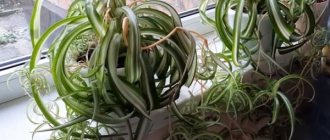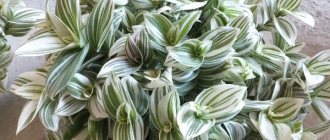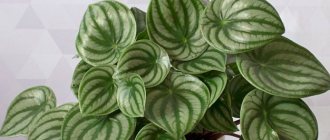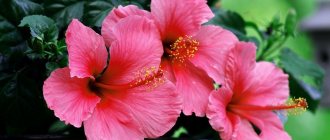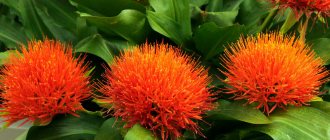Until recently, the Chlorophytum plant could be found in literally any house or apartment. It often decorated offices in various government agencies, hospitals, and schools. The thing is that people especially appreciated the unpretentiousness of chlorophytums, their amazing resistance even to difficult conditions. At the same time, the bush in most cases retains a neat and attractive appearance, no matter how bad it feels.
Dear readers! For you, we have created communities on social networks in which useful articles and interesting ideas are published several times a day! Subscribe and receive useful content in a convenient format!
Today, Chlorophytums are inexorably being replaced among the most popular indoor plants. They are being replaced by other exotic plants, but this does not mean at all that the time of Chlorophytums is irrevocably gone. Fans of these flowers even today find the process of growing these unpretentious evergreen bushes in pots interesting.
Indeed, the variety of Chlorophytum species, and about 200-250 of them are known only in the wild, will easily allow you to create an extraordinary decoration for any type of interior.
Caring for Chlorophytum after purchasing from a store
In general, Chlorophytum is a very unpretentious plant, so after purchase you can immediately begin replanting the flower in a permanent place.
On the other hand, it is recommended to wait at least two weeks after purchase without doing anything. During this time, you can make sure that the plant is not sick or infested with pests. In particular, during this entire period you should not feed Chlorophytum, as well as spray it and place it in bright sun. You also need to water it moderately.
After 2 weeks, it’s time to transplant Chlorophytum into a new container, since purchased soil is often very poor in minerals, which leads to stagnation in growth.
In a new pot, the flower must have completely new soil, and the container itself must be conducive to the growth of the root system, that is, be at least 3-5 centimeters larger in diameter than the purchased container.
By the way, you can treat the entire flower with a fungicide or insecticide for preventive purposes - this will prevent the development of diseases and the proliferation of pests when Chlorophytum’s immunity weakens in the first days after transplantation.
Growing conditions
Chlorophytums have always been highly valued for their high adaptability to indoor indoor conditions: dry air, relatively constant temperature throughout the year, limited nutrients in the soil, and ease of care.
On the contrary, it is more difficult for Chlorophytums to exist in the wild, because they tolerate high humidity less well, but geographically they grow precisely in tropical and subtropical regions where there is excess moisture for them.
BY THE WAY. Chlorophytum is famous for its ability to purify the air well. Therefore, it will not only decorate your home greenhouse, but will also be beneficial for the health of others. It is known that in the immediate vicinity of the Chlorophytum bush, up to 80% of pathogenic bacteria die. All this is thanks to the phytoncides that the flower releases into the environment. Three to four plants clean a room of up to 10 m2. They effectively absorb formaldehyde, carbon monoxide, and toxins that are dangerous to humans.
Therefore, for all varieties of Chlorophytum, there is practically no need to revise the care conditions established in the room where it will grow.
Chlorophytum in the wild
Temperature
In terms of room temperature, Chlorophytum is not very whimsical. He will be quite happy with the range of +15-25 Co. Do not need anymore.
In summer, the flower can and is even recommended to be moved to the balcony or open air (on an ongoing basis until late summer). However, it is only important to choose a place without strong drafts and not to allow large amounts of rainwater to fall on the foliage, otherwise the appearance of the bush will quickly deteriorate.
In the winter months, Chlorophytum will withstand even a strong drop in temperature in the room, but not for long. In general, this plant can be quickly destroyed only at a constant temperature below +10 C.
Air humidity
Chlorophytum has long been classified as a member of the Liliaceae family. But modern scientists classify this plant as Asparagus or Agave - opinions are still divided.
But all these families are characterized by growing in the wild in conditions of high humidity, although in fact, they require moisture within reasonable limits, no more. As for Chlorophytum, the frequency of watering is easy to work out. The soil in the pot should always be moist, but not too soggy, like in a swamp. On the hottest days, spraying will not hurt.
Dry air will certainly spoil the green cover: the leaves begin to dry first at the tips, and then all the way to the base. Therefore, sometimes you will need to humidify the air in the room. You can get by with a simple old-fashioned method - place a saucer of water nearby, which will gradually evaporate, naturally humidifying the air in the room.
It is especially important to pay attention to additional air humidification in winter, when the heating is on, drying out the room. It is for this reason, by the way, that Chlorophytum should be located at a distance from the batteries: at least 1.5-2 m.
Lighting
Remember that Chlorophytums, of all external care conditions, are the most picky about lighting. Their place should be illuminated with diffused light most of the day.
At the same time, the plant can withstand direct sunlight, but not more than a couple of hours a day, otherwise the delicate foliage will dry out quickly.
If you do not provide Chlorophytum with enough lighting, it will instantly wither and lose its healthy appearance. And if we talk about species that have variegated colors, then their leaves without proper lighting become standard, completely green without spots or patterns, that is, they lose their identity. On the other hand, when lighting is restored, the color quickly returns to normal.
Chlorophytum loves diffused light
Choosing a place to put a flower pot
It is believed that Chlorophytum feels almost ideal on the windowsill - where there is always enough light.
On the other hand, there may be little light on the north side, and too much direct sun on the south side. This gives rise to a logical conclusion: the best windows for placing Chlorophytum should face the western or eastern side. It will be light there most of the day, but the sun itself will not be too aggressive.
If I may say so, Chlorophytums are not averse to “taking a walk.” In the summer in the middle zone, they can be safely taken outside if conditions permit (for example, in a private house and your own yard). But you should choose the location more carefully: the flower will do well where there is no strong wind, and where rains cannot flood the root system, spoiling the appearance of the leaves.
Chlorophytum on the windowsill
History, legends
Indoor chlorophytum (photos, benefits and harms of the plant are described later in the article) have long been classified as a member of the lily family. Recent research by botanists has made it possible to move the flower into the classification of asparagus. There is still no exact definition, since the plant has characteristics of both families.
In nature, this herbaceous plant is found in the subtropical regions of Africa, Asia and South America. At home, chlorophytum prefers moist soils in valleys and on river banks. Its branched root system allows the plant to be used to strengthen slopes.
As a houseplant, chlorophytum quickly spread throughout Europe from the end of the 19th century. The Latin name of the flower translates as “green plant.” The first botanical description of a subtropical grass dates back to 1794.
The unique ability of chlorophytum to survive in any conditions has created its reputation as a family flower for the comfort and well-being of the home.
Several folk signs are associated with this plant:
- Chlorophytum is considered a male flower; its presence in the home of unmarried women should bring good luck in their personal lives. The plant develops its strength especially well in the vicinity of such “female” flowers as violets, begonias, and cyclamens. Thus, its energetic influence is enhanced.
- Slow growth or wilting of chlorophytum signals the presence of negative energy in the house.
- It is believed that the plant is capable of taking on the diseases of its hosts. At the same time, the flower itself fades and gets sick.
- One of the popular names for the flower is “family happiness.” Legend says that in a house where chlorophytum is well cared for, there are no quarrels, peace and mutual understanding reign.
Experts in the ancient Chinese teaching of space arrangement, Feng Shui, endow chlorophytum with many positive qualities. They recommend that everyone who moves into a new home be required to have plants. It is believed that several flowers in different parts of the house can cleanse it of the heaviest energy. To do this you need the correct placement of the flowerpot.
- It is useful to place chlorophytum in the darkest and most remote parts of the room, since negativity accumulates there.
- It is useful to place strong, dense plants in the place where the deceased person was.
- Chlorophytums in a place of rest will help relieve stress after a hard day in 30-40 minutes.
- A flower in the northern part of the house will help you make decisions to change your life.
- “Green Lily” in the office is associated with satisfactory business management and increased income.
- A plant in a schoolchild or student’s room helps in mastering educational material.
What does it look like in the interior?
One of the well-known names of some varieties of Chlorophytum is “Splash of Champagne”. So it was deservedly nicknamed, because of the characteristic tails at the ends of the shoots, which resemble air bubbles flying in different directions. In any case, these types of flowers will greatly decorate the interior, because they look quite exotic.
But most of the remaining Chlorophytums are not the most eye-catching indoor flowers. They are characterized by an abundance of foliage and a large number of developing shoots, but the appearance is quite familiar and standard. For this reason, Chlorophytum is easy to combine with any indoor environment, from the most conservative classics in design to modern ones: high-tech, modern, neo-modern, underground.
Chlorophytum in the interior
Features of care at different times
Depending on the seasons, caring for Chlorophytum differs little from caring for most other indoor plants.
in spring
Spring is the time of awakening of a flower after a long winter. Already from the first days of March, Chlorophytum can be fed. First, mineral fertilizers are applied, then organic fertilizers. But you need to wait at least 2 weeks before each application of fertilizer.
In spring, you can also replant the plant if it has already outgrown its container.
It is recommended to carefully monitor the lighting. The more light there is, the faster Chlorophytum will begin to grow and form lush foliage.
In summer
In fact, in the summer months, all Chlorophytum care comes down to maintaining humidity.
The summer is too hot and dry - you can even water the flower up to 2 times a day, morning and evening.
If the humidity is high, then the average frequency of watering should be once every 1-2 days.
It will not be superfluous to frequently spray the leaf plates with a sprayer. This way it will be possible to maintain ideal air humidity and create excellent conditions for Chlorophytum.
In the summer months, it is permissible to continue feeding the flower at the same frequency as in the spring.
If conditions permit, Chlorophytum can be taken out into the open garden in the yard or on the balcony for the summer.
in autumn
If Chlorophytum was taken out onto the balcony or into the yard in the summer, then in the fall it should already be in the room due to cold nights (it is ideal to bring the flower home in mid-August).
In the fall, it is not recommended to feed the plant at all, and you should also begin to gradually reduce the intensity of watering. At first, you can irrigate the soil 2-3 times a week, and by late autumn it is enough to water once a week.
in winter
Chlorophytum should be watered little in winter (once a week, and sometimes less, depending on the condition of the soil).
Usually standard room conditions will be sufficient for the flower. It is only important not to allow the temperature to drop below +10 C when caring for a flower, but, obviously, such a cold snap occurs infrequently in heated rooms.
It is also not recommended to place the container with Chlorophytum close to the batteries (should be at least 1.5-2 m), and in case of wilting, use humidifiers.
Benefits and harms, can it be kept at home?
Indoor chlorophytum (photo), the benefits and harms of which are explained by the chemical composition of its leaves, has a number of advantages:
- The plant is valued, first of all, for its ability to purify the air from harmful impurities and gases, which is especially important for residents of large cities. Flower growers advise adding a little activated carbon to the soil for chlorophytum to enhance the cleansing effect. It takes 24 hours for a flower to remove harmful elements, which makes it a champion in terms of usefulness among houseplants.
- The phytoncides that the flower secretes kill most pathogenic bacteria within a radius of 2 m. The antimicrobial effect is enhanced by proximity to geranium.
- Chlorophytum humidifies the air around it, which is especially important for people with respiratory problems and allergies. Four mature plants in a room are enough to create a microclimate that is optimally favorable for health.
- Healthy chlorophytum is never affected by insect pests and protects nearby plants from them.
- In the rooms where the flower is located, dust deposition is significantly reduced.
Chlorophytum is a unique plant for any home. It will purify the air in the bedroom and living room no worse than an air conditioner, and helps remove unpleasant odors in the kitchen. All the harmful substances that chlorophytum absorbs from the air contribute to its lush growth. What is harmful to humans is very beneficial for this plant.
Its ability to develop in any conditions allows the plant to be grown in rooms with varying degrees of light.
Indoor chlorophytum will be of great benefit in creating a microclimate at home; in addition, an adult plant with many “spiders” fits perfectly into any design (photos confirm this).
The only caution is the advice to keep the flower out of the reach of small children. Harm can be caused by too sharp edges of the leaves, which can injure the delicate skin and mucous membranes of the child.
How to care for young and adult plants?
In general, caring for a very young Chlorophytum bush or an already mature plant is almost no different.
Features can only be noted in the first days after purchase. It is recommended to quarantine for at least 2 weeks to allow the plant to adapt to the new conditions. To do this, water it moderately, do not feed it at all, and keep it in a cool place.
As it grows, it is also necessary to transplant Chlorophytum into larger containers. But since the formation of the root system in a flower occurs rather slowly (unlike green mass), this process is rarely resorted to.
Varieties and varieties
Basically, in home floriculture, only 5 varieties of Chlorophytum are most widely used, although more than 200 varieties are known in the wild. Other species, besides the popular varieties, are very rare and are found in greenhouses only by the most experienced gardeners, as they are more demanding to care for.
Crested Chlorophytum
Almost completely standard Chlorophytum with long, oblong leaves growing almost from the very root. In an adult and healthy state, the rosette of a bush can reach up to half a meter in diameter (that is, very lush).
A distinctive feature is that crested Chlorophytum shoots bare long shoots, at the end of which lush shoots with leaves or flowers (rarely) are formed. Thanks to this feature, such a flower is often compared to a fountain or those very “champagne splashes”.
Curly Chlorophytum
It is very different from the crested one in that it is noticeably smaller in size, its leaf plates are folded into neat spirals.
The leaves in the central part have a thin light stripe, which appears only in good light.
Winged Chlorophytum
A variety characterized by the presence of wide leaves with an orange color at the base.
This variety is considered decorative, as it rarely grows more than 50 centimeters in height.
Cape Chlorophytum
A flower that looks great thanks to its special leaf shape and color. With proper care, it can produce leaves up to half a meter long, although it itself looks quite short and compact.
Cream shades of the foliage border are truly rare, which is why they will invariably decorate the interior and attract attention.
Chlorophytum Laxum
This is a very rare variety of domestic Chlorophytum, which grows to a small size, and the most remarkable part is the foliage. Laxum's leaves are thin, with white stripes on the sides.
Types of homemade chlorophytum with photos and names
A little more than 200 species of chlorophytum are found in natural conditions. Only a few of them are cultivated at home.
Chlorophytum comosum
The most common type of chlorophytum. Elongated narrow (about 2 cm) leaves hang freely. They have a lanceolate shape and a bright green color. The arrow grows up to 100 cm, first small pale flowers (up to 7 pieces) form on it, then “baby”.
Some of its varieties are the most popular.
Variety (Chlorophytum Vittatum)
A narrow white stripe runs along the leaf blade.
Variety (Chlorophytum Variegatum)
Light stripes run along the edges of the leaf plate.
Chlorophytum comosum Bonnie
A compact bush with short, spiral-shaped leaves that give the plant a playful appearance. The center of the leaf blade is clearly marked by a cream stripe.
Orange chlorophytum, or star orchid (Chlorophytum orchidastrum)
A species radically different from other types of chlorophytum. The height of the bush is up to 40 cm. Wide powerful leaves on long orange petioles are alternately formed from the basal rosette. They have a dark green color. The short peduncle is shaped like an ear. “Children” rarely form.
At home, 2 varieties are often grown:
Variety (Green Orange)
A wide dark green leaf blade is supported by a bright orange petiole. The vertical stripe on the leaf has the same color.
Variety (Fire Flash)
It is distinguished from the Green Orange variety by the absence of a bright orange stripe; only a thin reflection of the bright petiole is visible.
Chlorophytum capense
Wide (3 cm) elongated (almost 60 cm) bright green leaves. They have a grooved shape. Small snow-white flowers are formed on short peduncles. The main difference from Chlorophytum crested is that as a result of flowering there are no “babies”.
Chlorophytum is an ideal plant for the home, found in almost every apartment. Lush greenery evokes positive emotions and purifies the air. Planted in hanging containers or florariums, “green plant” bushes enliven the space and emphasize its uniqueness.
Currently reading:
- Alocasia domestica. Growing and care
- Coleus - planting and care at home, photos of species and varieties
- Oleander
- Platicerium - home care, photo
- Duranta - home care, photos of species and varieties
Transfer
There is nothing difficult with transplanting Chlorophytums. Firstly, this plant does not need it very often, but only as the container is filled with roots (this can be seen by the clearly stopped growth). Secondly, the process occurs through the usual transfer, that is, with the preservation of a clod of earth from the old pot and the addition of new fertile soil.
It is best to wait until early spring to transplant. Then you can sufficiently feed the plant and reduce stress for it, since a time of growth and enhanced root formation is expected ahead.
Chlorophytum transplant
Landing
To plant Chlorophytum, you can use any universal soil. You can either buy it at a specialty store or prepare it yourself. The main condition is that it be loose enough for the not very strong root system of this plant.
The pot should be lined with drainage or fine expanded clay or coarse sand. Ideally you need about 3-4 cm of layer.
You will need a saucer under the pot in which Chlorophytum will grow. For the first time after planting, fresh soil is well shed, and the excess moisture that has accumulated over time in the saucer is drained. For some time (namely, about a week) the flower is placed in the shade.
Interesting facts about chlorophytum
It has been noticed that signs and superstitions associated with chlorophytum are only positive.
Feng Shui
According to the teachings of Feng Shui, chlorophytum is the safest plant for a home and its inhabitants. It thoroughly absorbs negative energy and releases positive energy instead.
If suddenly a flower begins to fluff up, produce babies and become prettier right before our eyes, it means that it absorbs all the carbon monoxide, nitrogen and everything that is bad in the house.
It is recommended that after a difficult event, sit down next to the “doctor” and talk about your sorrows. After a few minutes of conversation with chlorophytum, a person will be in a good mood.
It transmits male “Yang” energy. To balance the energy, you can place “female” flowers (violet, crassula) nearby. If the flowerpot is placed on the north side, career advancement or other positive changes in the life of the owners of this plant will begin.
Reproduction
There are several effective ways to propagate Chlorophytum. All of them are familiar and classic, relevant for all indoor flowers:
- Dividing the bush.
- Rooting rosettes at the root.
- Seeds.
Reproduction method by dividing the bush
This option can be chosen for those bushes that have grown greatly. Then, using a sharp knife, they are divided into several smaller bushes, and the cuts are treated, for example, with charcoal (so that they do not rot).
After this, each new sprout is planted in a separate bowl.
Rooting rosettes and shoots
Here it is important to choose a strong root shoot or cutting that grows from the main rosette at the base.
At first, the shoot is placed in a glass of water. Later, when the root system is formed, the cuttings can be planted in the first small container with soil. The soil, by the way, will need to be nutritious and rich in minerals (can be used with fertilizing).
Reproduction of Chlorophytum
Seeds
There are varieties of Chlorophytum that can only be propagated by dividing the bush or by seeds, since cuttings are not formed on them.
If you choose the seed method, then the cultivation steps are quite standard. First, purchased seeds must be soaked in water at room temperature for at least a day. You can add the growth stimulator Epin to it.
After this, plant the seeds in a container with sand and peat soil, pressing them in slightly. Spray the planting with a spray bottle and cover with cloth or film.
The container should be left in a warm (+22-26С) and well-lit place. When Chlorophytums with at least 3 formed leaves sprout, they need to be transplanted into small containers one at a time.
A little later, when the plants take root and grow, they are planted in a permanent place.
Kinds
In the natural habitat, there are about 250 varieties of chlorophytum. Several species have been adapted for indoor keeping, some varieties of which have already been bred through selective breeding.
| View | Description | Peculiarities | Varieties |
| Crested | It grows in the form of a lush bush, long curved leaves are collected in small bunches. The color of the leaves depends on the variety. Flowers are white inflorescences on long shoots. | The most common indoor type. It can fire several arrows at the same time, which turn into new bushes. As a result, the flower becomes like a green fountain. Easy propagation by air layering. |
|
| Cape | The bush is a rosette with wide large leaves 60-80 cm in length. The leaves, pointed at the ends, have a groove in the central part. Leaf color is glossy green. The flowers are white paniculate, located on a short peduncle. | After flowering, it does not form air layering; it reproduces only by division. | |
| Winged (orchid star) | The leaves are large, oval, 30-40 cm in length. Appearance - a bush with long fleshy cuttings of bright shades from brown to bright red. Peduncles are short cobs. | Significantly different from all types. Can be propagated by division or seeds. Does not like direct sunlight. The combination of bright roots and green leaves creates an unusually attractive appearance. |
|
| Laxum | Narrow drooping leaves form a tall, dense rosette. The leaf color is green with a white stripe. Peduncles are low, spike-shaped shoots. | A very rare species. Does not produce air layering. Propagated by division or seeds. |
Watering
The tactics for watering Chlorophytum can hardly be called complex.
- In spring and summer, during the period of active development of the root system and foliage, the flower should be watered abundantly. On hot days, the intensity of watering reaches once a day (and in extreme heat even twice a day).
Water the flower either early in the morning or in the evening after sunset.
- In the cold season, the frequency of watering should be reduced. The minimum intensity is usually recommended at 1 watering per week. However, it is worth constantly monitoring the condition of the soil in the pot - it should be moist and not dry out too much.
Chlorophytums also respond well to spraying from a spray bottle. If you do this constantly, every day, you can achieve especially rapid flower growth.
ADVICE. Some varieties of Chlorophytum love spraying, but in order not to spoil the appearance of the foliage (or rather, to protect it from the appearance of stains, stains and putrefactive formations), it will be useful to wipe off excess drops from the leaves after each spraying.
Rest period
October-January is a mild period of rest. It is advisable to water the plant less often and not fertilize it. The temperature is several degrees lower.
In cold rooms, be especially careful about watering - do not overwater the plant to avoid root rot, and make sure that the temperature does not drop below +10°.
Chlorophytum roots before transplanting
Top dressing
There is no consensus on feeding Chlorophytum. There are those who quite rightly claim that for proper care, the flower needs to be fertilized once a year - in early spring. It is worth recognizing that there is some truth in this, since Chlorophytums are extremely unpretentious to the mineral composition of the soil. They literally can grow calmly in soil of normal composition.
On the other hand, it is difficult to argue with the fact that for intensive flower growth, mineral fertilizers and nutrients must be present in sufficient quantities in the soil. Therefore, those who want to grow a Chlorophytum bush faster and achieve a healthier, fragrant appearance should add additional fertilizing to the soil.
As a rule, you can buy standard mineral complexes for indoor plants and alternate them with conventional organic fertilizers.
Fertilizers should be applied no more than once every two weeks. The feeding period begins in early spring and continues until the end of summer.
Watering and fertilizing chlorophytum
Diseases and pests
It is well known that Chlorophytum has good immunity, which is especially resistant under good room conditions.
Occasionally you can find damage to a flower by insects such as scale insects and aphids. Thrips infections are even less common. As a rule, all problems disappear after treatment with insecticides in accordance with the manufacturer's instructions.
And in order to prevent the recurrence of the disease or the rapid return of pests, reduce soil moisture. Almost always the problem lies in excessive dampness.
Useful properties of the plant
After numerous studies, scientists were able to prove that chlorophytum has a truly unique ability to remove formaldehyde, all kinds of toxins and impurities from the air around it. The phytoncides secreted by its leaves purify the air in the room from pathogenic microbes and saturate it with oxygen. It has been proven that in just a day, the flower kills about 80% of the bacteria in the air surrounding the bush. Three or four mature plants can easily clean a 10-square-meter room. m.
A flower placed on a kitchen windowsill absorbs harmful emissions from electrical and gas appliances. In the vicinity of pelargonium (indoor geranium), chlorophytum absorbs dust and microbes in rooms. For this feature it is often called a vacuum cleaner flower. The plant regulates the air humidity in the room and also improves its microclimate, since the leaf plates accumulate moisture and then release it into the surrounding atmosphere, being a kind of natural air humidifier.
By growing chlorophytum in your apartment, you can automatically improve your quality of life. This is especially important for people who suffer from bronchial asthma, allergies or low immunity.
Common mistakes
Chlorophytum foliage darkens - most likely this is a sign of some kind of physical damage. In rare cases, the problem may be too high a temperature or too much humidity.
Monochromatic leaves grow on variegated chlorophytum - in most cases, a sign of a serious lack of light. The problem goes away very quickly after changing the location of the pot.
The formation of rot is almost always associated with stagnation of liquid in the pot. They get rid of rot by significantly reducing the intensity of liquid application. By the way, sometimes rotting in Chlorophytums begins due to an incorrectly selected soil mixture - too dense a structure leads to flower diseases.
The tips of the leaves are fading - this means that the plant clearly does not have enough moisture. But this does not necessarily apply to watering. Sometimes this painful appearance is caused by too dry air in the room.
Is it dangerous for cats?
Many cat owners are worried that some pets bite the leaves of chlorophytum. Indeed, many cats like the taste of this plant. There's no need to worry. The grass cannot cause any harm. Rather, on the contrary, the microelements that are present in the juice of the plant have a beneficial effect on the digestion of animals.
Cats often vomit after ingesting chlorophytum leaves. This fact gave rise to the myth that the flower is very harmful. In fact, this action cleanses the cat's stomach of the hair that has accumulated there. For thick-haired breeds, veterinarians even prescribe special products that cause a gag reflex.
Answers to popular questions
Why do the leaves/shoots turn black or dry?
The very first reason is improper watering. Basically, this means that the plant is not getting enough moisture. Another common reason is that there is not enough space in the pot for the root system.
Why did the leaves droop?
This process also has natural reasons. For example, Chlorophytums lower their foliage slightly at night due to lack of light. But if the phenomenon is permanent, then most likely the flower is cold (room temperature +10 C or less).
Chlorophytum not blooming?
This is a double-edged sword, because everything depends on the variety. Very often it is really difficult to achieve Chlorophytum flowering. But if you choose a variety with constant flowering, then it is important to understand that young plants do not bloom for a long time. They need 2-3 years to reach adulthood.
What to do if the roots rot?
Basically, the main reason lies in poorly permeable soil. The situation can be corrected only by transplanting the flower into the correct soil (in this case, emergency measures are needed, so replanting can be done not only in the spring, but also at any other time of the year).
Why has growth slowed?
Perhaps the reason for everything lies in the small pot. Sometimes growth slows down if the flower lacks light or moisture.
The leaves are the same color, what should I do?
Variegated species can indeed sometimes grow with completely green foliage, losing their identity. Almost always, the main reason for this phenomenon is a lack of lighting. You should change the location of the plant or organize artificial supplementary lighting.
Botanical description
Chlorophytum is a herbaceous plant that forms a rosette of long, narrow and dense leaves. In indoor conditions, their maximum length reaches 80 cm ; in nature, the leaves can grow up to 120 cm in length. Their color depends on the variety and variety of the plant.
Chlorophytum flowers are small, paniculate, white or pinkish in color, located on long hanging stems (in some species they are placed on short peduncles). After flowering, new rosettes of leaves with aerial roots appear on the hanging shoots.
These new bushes can grow in the air for a long time, without soil, and produce new shoots. Because of this property, chlorophytum received the popular name “spider”, “air lily”. Period of abundant flowering: May-June. The root system is strong, with many shoots.
Conclusion
Chlorophytums are surprisingly unpretentious indoor plants and this is perhaps their most important advantage. This is what explains their great popularity, which even today has fallen, but is still high.
Chlorophytums are perfect for growing for beginners. But professionals will also be able to find a lot of interesting things for themselves if they give preference to rarer, more care-demanding, exotic varieties.


